POCKET-HOLE JIGS
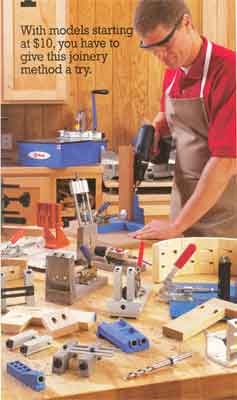 |
If there's a faster, simpler, and stronger joinery method than
pocket holes and screws, we'd like to see it. Using pocket-hole joinery,
glue-ups are virtually clamp-free whether you're edge-joining boards for
a tabletop, assembling a face frame, or building a drawer. (If you're
not familiar with the technique, check out the pocket-hole primer on
page 26.)
So, what about the jigs that make pocket holes possible? We gathered 18
models selling for $10 to $800, put them to the test, and found what
characteristics— besides price—separate them. Now, we're prepared to
name the Top Tools and Top Values in four price ranges.
What makes a good pocket-hole jig?
Drill guides. These steel tubes guide the drill bit at an angle as you
cut the pocket hole, and the constant reaming by a sharp bit can take
its toll. Several jigs showed signs of scoring inside the guides after
boring about 40 pocket holes, suggesting they'll wear faster than those
without scoring. And, although some steel shavings from the guides are
acceptable for the first few holes while the bit and guide break in
together, the Rockier 21296 (above right) continued to spit out metal
well into our tests.
Pocket holes usually are made in pairs, so a jig with two drill guides
saves you time if you can drill both pockets with only one setup. For
making 1 1/2" face frames, we find 7/8" spacing between the holes to be
perfect, and most of the two-guide jigs deliver.
Several jigs are adjustable to increase the spacing for wider
workpieces, but only two—the Task Pro Center 06250 and Kreg K2—can go
narrower. Of course, for spacing above or below the ranges shown in the
chart on page 64, you simply move the jig, and drill the pockets
individually. Portability. A less-portable jig isn't necessarily a bad
thing; it's merely a question of whether you bring the jig to the
workpiece (as you would do for a large or built-in project), or the
workpiece to the jig. Low-cost jigs without built-in clamps tend to work
better on large projects: They're smaller and easier to clamp in tight
spacesthan the more-expensive benchtop jigs. However, most are awkward
to use on a benchtop (except for Pock'It, which, with its flat bottom
and built-in clamp, is similar to the more-expensive benchtop jigs).
When you can bring the work to the jig, most benchtop jigs (priced $70
and up) have built-in clamps that make positioning and securing the
workpiece fast and easy. These jigs also typically have a stop to
positively locate the workpiece on the jig. |
Adjustability for stock thickness.
All of the pocket-hole makers in our test are designed to center the
screw-exit hole in 3/4" stock. Can you work thinner or thicker pieces?
Sure, within about !/s" or so, but the screw won't be centered in the
end or edge of the workpiece—it isn't a problem, but it's not ideal,
either.
A few readily adjust to bore centered holes in 1/2" stock, a common
thickness for drawer sides. The Kreg Rocket and ProPack come with spacer
blocks that change the placement of the holes to accommodate 1/2"- and 1
1/2"-thick stock. They're easy to install, but also easy to misplace.
CMT's Pocket Pro (see photo below left) is the only jig with positive
stops for ten thicknesses of material from 1/2" to 1 5/8".
"Pluggability." Although most
pocket holes will be hidden inside cabinets and beneath tables, there
may be times when they show. You can plug them with dowels, and some
manufacturers sell specially cut dowel segments, or you can make them
yourself.
To help the plugs blend in, you want a pocket hole free of tear-out, and
most of the jigs delivered acceptable results when boring with the
grain. Cross-grain cuts (such as you might make when edge-joining a
panel or tabletop) were a different story, especially for the
$20-and-under crowd. The Kreg Mini, shown at lower right, and the
Pock'It were the only low-cost jigs that left us with a pluggable pocket
across the grain.
Two of the most expensive pocket-hole makers cut unpluggable holes, but
for different reasons. Because the Porter-Cable 552 creates a curved
pocket (see photos, above right), a dowel won't do the trick. FaceMaker
500 leaves the pocket screw slightly proud of the workpiece, so you
can't hide it with a plug.
Top-dollar jigs uniquely suited to
production pros
Once you try pocket-hole joinery, you might find yourself addicted to
the ease and speed of assembling projects. (Some pocket-hole-obsessed
craftsmen actually boast about the number of pocket holes in their
projects!) The $330+ jigs are designed for high-productivity shops with
budgets to match, but we thought you might like to know about them in
case you're ready to take the next step.
Kreg's two entries in this price category bore pockets in the same basic
manner as the least expensive jigs, but they automate at least part of
the process. The K200 consists of a drill chuck and bit guided by a pair
of spring-loaded plunge rods, and a pedal-activated pneumatic clamp.
Mount your own power drill to the K200's chuck, position your workpiece
on the jig, and step on the pedal to clamp it in place. Then drill the
pocket as usual.
The Kreg Foreman, on the other hand, is an automatic, entirely pneumatic
pocket-hole machine. Position the workpiece flat on the Foreman's table
(two flip stops provide excellent repeatability), and pull the lever
forward. In a flash, a clamp secures the workpiece, and the step drill
bit bores the pocket from below. The whole process takes less than 2
seconds.
Porter-Cable's 552 takes an unusual two-step tack to pocket holes. After
manually clamping the workpiece to its tabletop, you push a lever
forward, and then pull it back. Each action creates part of the pocket
hole, as shown above.
Expect longer bit life from the automated and semi-automated jigs from
Kreg and P-C. Machine-guided bits drill straighter and with less stress
on the cutting flutes than human-guided bits.
FaceMaker, designed specifically for face-frame construction, is more an
assembly jig than a true pocket-hole jig. Insert two frame pieces to be
joined, and self-centering clamps position them for drilling. After
drilling the pocket holes, you drive the screws right through the guide
holes without unclamping the assembly. The process works well, but seems
antiquated by the standards of other pocket-hole jigs in this price
range.
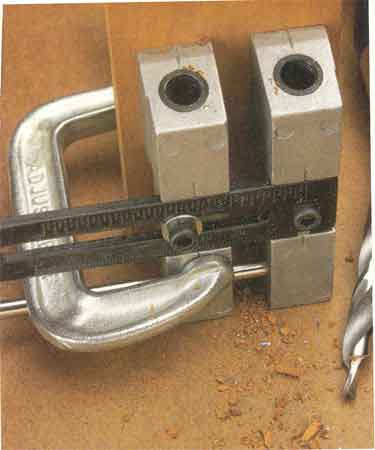 |
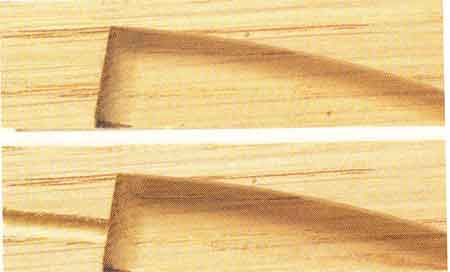 |
| The guides on Rockler's 21296 didn't hold up well in our test. Even
after boring more than 50 pocket holes, we still found steel shavings
among the wood chips. |
Porter-Cable's 552 swings a straight router bit up into the
workpiece to create an arch-shaped pocket (top). Then, a drill bit
plunges into the end to create the screw pilot hole (bottom). |
| |
|
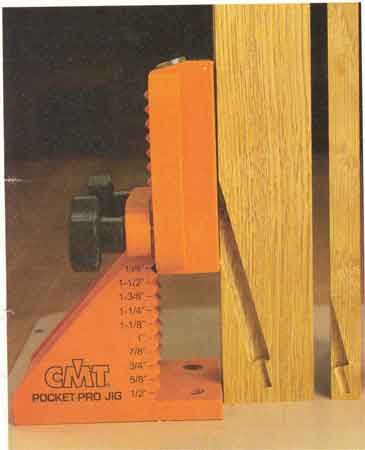 |
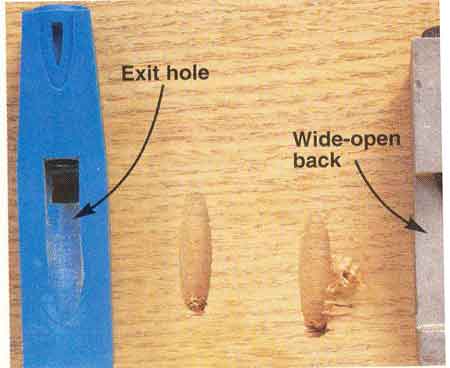 |
| Whether you're making pocket holes in 1/2"-thiñk drawer sides
(right), 1 5/8"-thick bed rails (left), or something in between, the
Pocket Pro easily adjusts to any 1/8" increment within that range. |
|
Our picks of the pocket makers in four
price ranges
Sometimes, the original is still the best, and Kreg Tools pulled off an
amazing, unprecedented sweep of our top recommendations in all four price
categories.
■ $ 10—$40 . The Kreg
Mini cut the cleanest pocket holes and comes with a step drill bit and a
lifetime replacement warranty on the guide, so we named it the Top
Value. Nothing else comes close in this price range.
|
■ $65—$80. The Kreg
Rocket combines the portability of lower-priced jigs with the capacity
and performance of more expensive models to earn Top Tool honors in this
price category. |
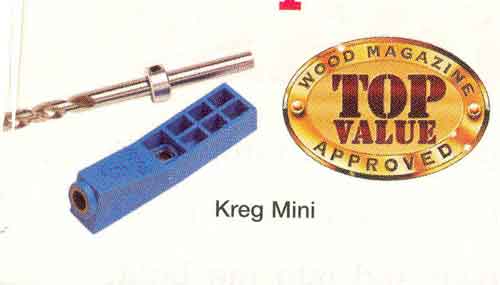 |
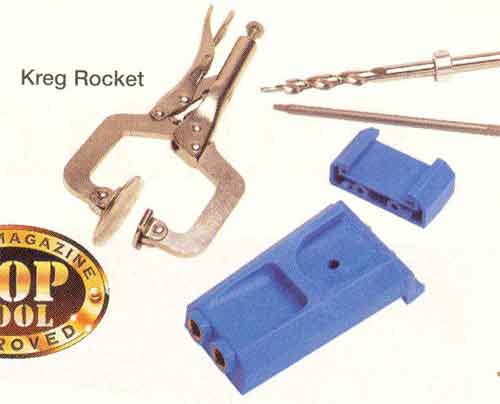 |
| |
|
| ■ $ 100—$ 150. Got a
little more money in the budget? The Kreg ProPack earned high marks in
our test, and comes with everything you need to put a pocket hole almost
anywhere (including the Mini, Rocket, and K200 benchtop model). So, the
ProPack is our Top Tool in this price range. |
■ $330—$800. Of the
high-dollar models, we'd take the Kreg Foreman, which couldn't be easier
to use. This Top Tool, however,
is also at the top of the price range, and requires an air compressor
that can deliver
I 5.3 cfm at 90 psi. |
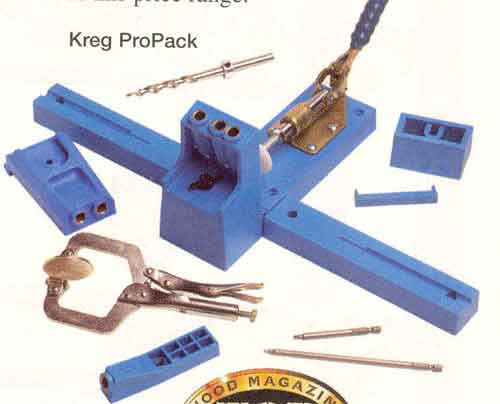 |
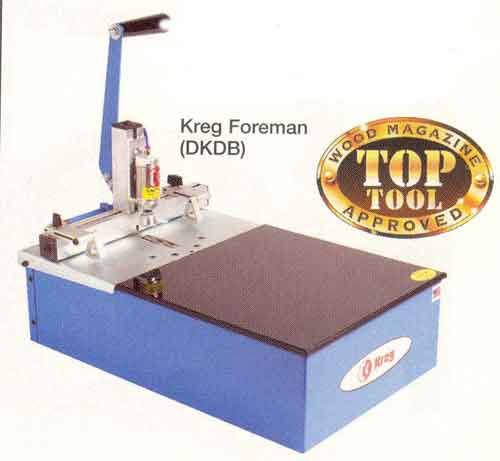 |
Ñâîäíàÿ òàáëèöà îïèñàíèé








